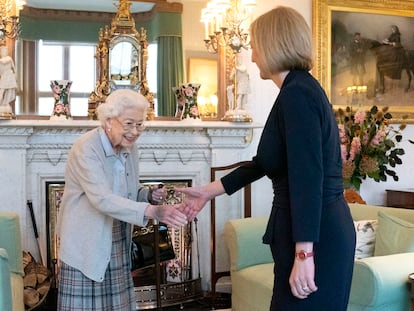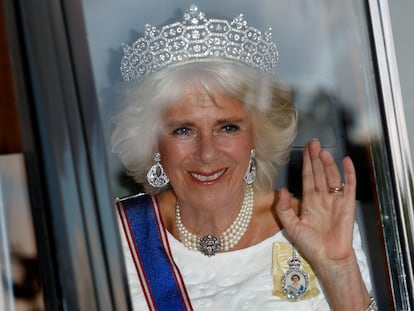Jewels, stamps and 32,000 swans. What will happen to Queen Elizabeth II’s vast fortune?
The estate linked to the Crown will pass automatically and tax-free to Charles III. But her private fortune can be distributed freely and secretly

Queen Elizabeth was not only the queen of the United Kingdom, but also one of the richest people in the world. And while it is already known who will inherit the crown, there is less certainty about what will happen to her fortune. Elizabeth II’s private wealth amounts to £370 million (about €426 million, $429 million), according to the Sunday Times Rich List in 2022. These are rough estimates, since the queen does not have to publicly declare her private finances. If all the assets associated with the Crown – which do not belong to her personally, but to the institution – are taken into account, her total fortune could exceed £14 billion (just over €16 billion, $16.2 billion). Understanding the difference between the monarch’s private wealth and the Crown estate is key to understanding how Elizabeth II’s fortune will be distributed.
“It is necessary to distinguish between the assets and personal rights of Queen Elizabeth II, which will form part of her inheritance, and will be referred to in her will; and those other assets and rights that belong to the Crown, and that, therefore, will be passed on according to the laws of the Crown,” explains Professor Sergio Llebaría Samper, professor of Civil Law at Spain’s Esade Law School, by email. “Her will cannot interfere with these assets,” he says, which will automatically pass on to her successor, King Charles III.
The new monarch will inherit the Crown Estate, a real estate business belonging to the Crown, but managed independently, from which he will receive 15% of the profits. This includes properties such as the important shopping strip Regent Street, in London, and the Ascot racecourse. There are also farms, forests and coastlines, accounting for around 1.4% of land in England.
In this section is also the Duchy of Lancaster, which consists of land holdings the British royal family has acquired over 700 years. The estate includes 18,000 hectares of land, nine castles and various real estate properties. These two real estate networks - the Crown estate and the Duchy of Lancaster - make up only a part of the extremely complex finances of the Windsor house. Indeed, this business empire is so complex it has been nicknamed the Firm.
The practice of sealing royal wills began with the death of Prince Francis of Teck in 1910
People do not usually inherit a salary, but that is not the case for King Charles III. In his new position, he will also receive the so-called “sovereign grant,” a sum that covers the costs of travel, security, staff and maintenance of royal palaces. The queen received a £85.9 million (€99.1 million, $99.65 million) sovereign grant in 2021.
But this is far from not the strangest inheritance that Charles III will have to deal with. He will also have to manage 32,000 swans and an unknown number of dolphins, whales and sturgeons. For more than 800 years, specimens of these species that live freely in the waters of the United Kingdom have been considered the property of the British monarch. This measure was taken in the 12th century, when swans were a delicacy and under threat from poaching. In order to preserve their population, they were made the property of the reigning monarch, along with whales, dolphins and sturgeons. Thus, albeit symbolically, Charles III will inherit a considerable number of animals along with the crown.
All these assets will be passed on to the king in full, tax-free. According to British law, inheritances that passes from consort to sovereign (as in the case of Philip of Edinburgh to Elizabeth II) and those that pass from sovereign to sovereign, as in this case, are exempt from paying the 40% estate tax that applies to any inheritance over £325,000 (€375,000, $377,000).
All eyes are on Queen Elizabeth’s private assets, those that she will be able to freely distribute among her descendants. It is likely that this fortune will be divided among her four children: Charles, Princess Anne, Prince Andrew and Prince Edward, and her eight grandchildren. But she is under no obligation to do so. “English law is characterized by a broad testamentary freedom,” explains Professor Llebaría. “There are no mandatory heirs [as there are in Spanish law, for instance], unless the judicial authority declares that part of the inheritance must go to relatives in a state of economic dependence on the deceased.” As this doesn’t appear to be the case here, the queen would have had complete freedom to bequeath her private assets as she pleased and, if she wanted to, she could have decided to leave out some of her children and grandchildren.
Queen Elizabeth’s private assets include residences closely related to the Crown, such as Balmoral Castle, her summer residence and place of death, and Sandringham, where she usually spent Christmas. It also includes private wealth estimated at £370 million, an impressive collection of jewelry and another, less brilliant but equally valuable, collection of stamps. What will happen to these assets is not known and will probably not be known for another 100 years. Since 1911, the British royal family has managed to get around UK law, which requires that the wills of British citizens be made public.
The practice of sealing royal wills began with the death of Prince Francis of Teck in 1910. In his will, this well-known womanizer bequeathed his family’s most valuable jewels to his mistress, a noble and married woman. Queen Mary of Teck, Francis’ sister, asked the court to make her relative’s will secret to avoid a scandal. And she succeeded, setting a precedent that the Windsors have clung to every time a family member has died. During this time, the family has asked the court to keep 33 wills secret, while assets worth at least £187 million (about €223 million, $217 million) by today’s standards have been distributed behind the public’s back, according to calculations by The Guardian. The court has never rejected one of these requests.
It is unlikely that Queen Elizabeth’s will contains lovers, secrets or a discretionary distribution of family jewels. But the Windsors will no doubt request that it be sealed, as they have been doing for more than a century. Thus, nothing can be known about possible beneficiaries (and losers) of the will. In the Windsor family, dirty linen is washed behind closed doors at the palace. And fortunes are shared with equal discretion.
Tu suscripción se está usando en otro dispositivo
¿Quieres añadir otro usuario a tu suscripción?
Si continúas leyendo en este dispositivo, no se podrá leer en el otro.
FlechaTu suscripción se está usando en otro dispositivo y solo puedes acceder a EL PAÍS desde un dispositivo a la vez.
Si quieres compartir tu cuenta, cambia tu suscripción a la modalidad Premium, así podrás añadir otro usuario. Cada uno accederá con su propia cuenta de email, lo que os permitirá personalizar vuestra experiencia en EL PAÍS.
¿Tienes una suscripción de empresa? Accede aquí para contratar más cuentas.
En el caso de no saber quién está usando tu cuenta, te recomendamos cambiar tu contraseña aquí.
Si decides continuar compartiendo tu cuenta, este mensaje se mostrará en tu dispositivo y en el de la otra persona que está usando tu cuenta de forma indefinida, afectando a tu experiencia de lectura. Puedes consultar aquí los términos y condiciones de la suscripción digital.
More information
Últimas noticias
Most viewed
- Sinaloa Cartel war is taking its toll on Los Chapitos
- Oona Chaplin: ‘I told James Cameron that I was living in a treehouse and starting a permaculture project with a friend’
- Reinhard Genzel, Nobel laureate in physics: ‘One-minute videos will never give you the truth’
- Why the price of coffee has skyrocketed: from Brazilian plantations to specialty coffee houses
- Silver prices are going crazy: This is what’s fueling the rally











































